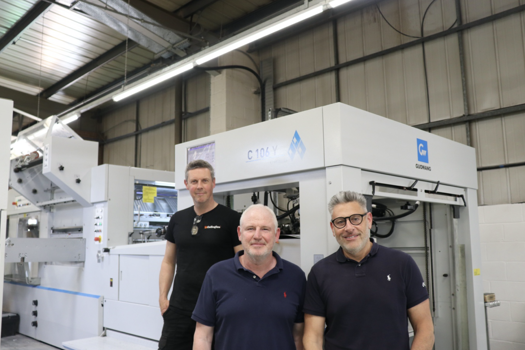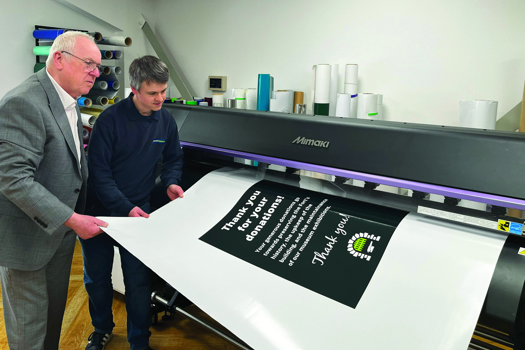To combat this, an increasing number of print sector stalwarts are looking to their window dressing – the outward-facing aesthetics, structures and strategies defining their brands. ‘If it ain’t broke, don’t fix it’, so the adage goes – but a fresh lick of paint can’t hurt.
Leading by example, the BPIF itself recently underwent a high-profile overhaul of its image, focusing on clear lines, bold colours and minimalist type to reflect the print landscape in 2019. Launched in July, the new branding now defines the federation’s website, literature and events.
Head of marketing Anaïs Bellemans says: “Our industry is fast-changing, and we need to constantly reflect how we change and adapt. We need to be at the forefront of the changing culture and be able to represent all sectors within our industry.
“We ran brand workshops to ensure we had varied viewpoints, we had strong involvement from our stakeholders, supply chain partners and member companies, and a selection of our staff and leadership teams were involved in the process.
“Print communications have been going for a long time and are currently going through radical changes in a thriving industry, so we needed to ensure we had the ability to adapt and anticipate changes. This was not a re-badging exercise, we wanted to represent who we are now and where we are going.
“This ethos of change is so we are all aligned in moving forward internally towards the future.”
Print’s all over it
Rebranding among print companies has proliferated noticeably of late.
In June 2018, PrintWeek reported on the extensive top-down rebrand of GI Solutions, which became the far-reaching Go Inspire Group in a bid to consolidate its multiple acquisitions into a coherent, streamlined group. Soon after, Falkland Press overhauled its look and transformed into the modern, forward-thinking Printed Easy.
The thread continued through to the new year, with luxury printer Geoff Neal Group completing an exhaustive four-year rebranding initiative to “put more of our personality into the way we do business [and] come up with a new identity based around perfection in print,” as chief executive Sam Neal put it at the unveiling.
More recently, Delta Group unveiled its new logo and website in May, having restructured its business into three distinct departments of Creative, Display and Technology to simplify its interaction with clients and provide a chance to “rethink and refocus,” according to chief executive Jason Hammond.
At the end of July, Paragon Group took the headlines with a major rebrand of its graphic services business, which compiled acquisitions Service Point, Magenta Print & Display and Kingswood iOptus under the single banner of Service Graphics.
Described as a “superbrand” by chief executive John Eager, it represents sales of more than £60m with 600 staff and a network of 40 high street and business park locations. It revealed a new look, designed in-house, which features a bright colour palette and circles motifs.
Beyond the printers
Print is, by its nature, obsessed with the visual. As printers themselves dig deep into the looks of their brands to convey clear, professional images, so too is it important that the companies and entities serving them in the supply chain must come up with the goods, aesthetically speaking, to be taken seriously.
Cumbrian papermaker James Cropper launched new branding and a new-look livery for its vehicle fleet in December, having undergone an extensive creative collaboration with design studio Foldability. The work was based off the shapes and lines of four special paper sculptures that had been created by Foldablity’s Kyla McCallum to emphasise the possibilities of paper.
“A logo or identity is just a small part of the overall branding of any business or product, but for James Cropper, our livery has always been a vital touch-point for current or potential customers,” says chair Mark Cropper.
“As such, when we’ve evolved, so has our fleet. The rebrand has enabled us to carry a modern expression of our colour and papermaking expertise straight to the customer.
“Companies should consider if they are missing a vital opportunity to connect with their customers and showcase areas of expertise in the experience they offer. While it’s just one factor to think about, I believe that for any rebrand to resonate it should have an authentic provenance to help bring the brand story to life.”
Perhaps more alert to the changing aesthetic demands of the market than most are the trade shows – with the need to pinpoint the latest trends and innovations of a specific moment in time every year. Annual expo Sign & Digital UK overhauled its look for its 30th anniversary in 2017 and is set to do so again for 2020 in a bid to stay as fresh and up-to-date as the industry it reflects.
Exhibitor marketing manager Jane Lewis says: “We are a visual communication show so the industry will always expect something interesting and challenging – we are seen as a leader and a place for innovation, but you cannot just be new for the sake of new.
“I think you have to think about why you are doing a rebrand and you have got to push what you are good at because people can get used to one thing and be blinded by it. Keep people interested, talk to outside voices like designers and do a bit of research into how your brand is perceived.
“It is important that as an industry we look like we are pushing forward, but you have to keep your core strong so that people keep coming back.”
OPINION
A great rebrand is all about getting the strategy right
 Jonny Aldrich, co-founder and managing director, Deuce Studio
Jonny Aldrich, co-founder and managing director, Deuce Studio
When a company rebrands, it’s not just for aesthetic reasons – it’s because there has been a change within the company, such as a new challenge, a shift in services or product offering that improves its capabilities or focus in some way.
But often, it can be because the brand is beginning to feel outdated and isn’t attracting the right audience, therefore a rebrand is a great chance to assess all your print and digital materials to see if they are communicating at their very best.
At Deuce Studio, we believe what makes a successful rebrand is a great strategic grounding.
We first need to understand a company’s vision, what it stands for and its core values before being able to convert this into a visual and verbal design language. We immerse ourselves in the brand, live and breathe their way of thinking so we are able to communicate this through a unique, memorable brand identity that will stand the test of time.
Once the strategy is in place, it’s down to the designers to be able to communicate this, applying it to a range of different deliverables in an interesting and engaging way so that the brand has enough flexibility to be able to grow and adapt.
That’s why a brand is not just a logo, it’s a sum of parts that all come together to communicate a core message. This could include graphics, patterns, colours, illustrations, icons, typography, words and much more to be able to do your new message justice across all the different areas that your brand will touch.
It’s not rocket science, but achieving the right feeling for the right audience in a new and engaging way can be tricky. Trusting in the strategy process will yield effective design in the creative stage and will result in a new brand that your audience will connect with and be proud to be a part of.
READER REACTION
What lessons did you learn from your company’s rebrand?
 Simon McKenzie, managing director, Hollywood Monster
Simon McKenzie, managing director, Hollywood Monster
“When we rebranded in 2009, we were merging Hollywood Signs and Monster Digital. They had the same shareholders and similar clients. By merging, we made something really efficient and wanted to rebrand to make it stronger and more credible. We spent about £75,000 on creative agencies, which I thought was a lot at the time, but I genuinely think if we had kept our older branding we would not be where we are now. You want to be taken seriously by the clients you are talking to, so it is worth investing money in great creative.”
 Jason Hammond, chief executive, Delta Group
Jason Hammond, chief executive, Delta Group
“We did a whole strategy piece before rebranding, going through our vision and brand values, which are hugely important. You need to establish a tone of voice and your USP, so you know how to communicate to clients. Our rebrand was about being agile and client-centred, with everyone empowered internally and externally. It has had a positive reception; engagement is up 60%-70%. It is key not to set a deadline and rush. This is your own business and must not be restricted. Do the preparation and invest time in getting it right.”
 Rachael Hunt, creative marketing manager, Visual Print & Design
Rachael Hunt, creative marketing manager, Visual Print & Design
“A lot of ideas came up when we were considering our new logo, as we had a look that was quite well-known and were trying to modernise. We had our internal graphic design team, but we also put it out to our top clients so they could feed back. They were really behind it. It was about getting across that we are about communication and direct contact with clients. Now, we need to work to increase brand awareness and making sure everyone knows we are brilliant so that the opportunities of our new look do not pass us by.”










